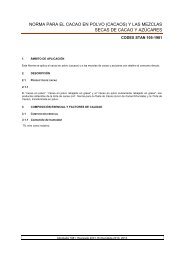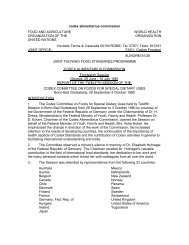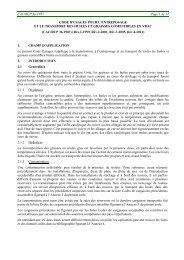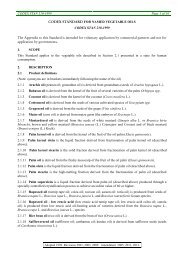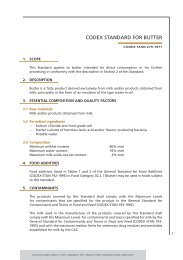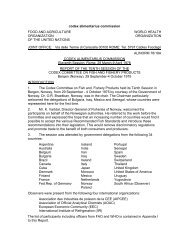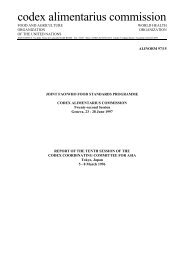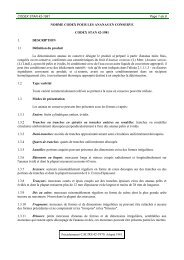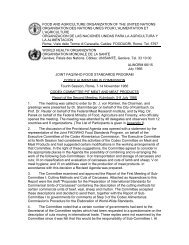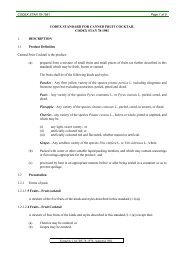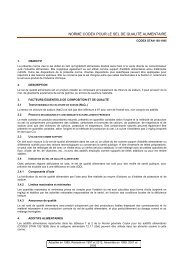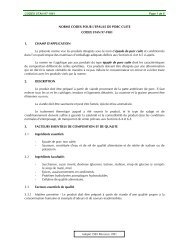REP13/FH JOINT FAO/WHO FOOD STANDARDS PROGRAMME ...
REP13/FH JOINT FAO/WHO FOOD STANDARDS PROGRAMME ...
REP13/FH JOINT FAO/WHO FOOD STANDARDS PROGRAMME ...
Create successful ePaper yourself
Turn your PDF publications into a flip-book with our unique Google optimized e-Paper software.
<strong>REP13</strong>/<strong>FH</strong> Appendix V 60<br />
PROJECT DOCUMENT<br />
Development of a Code of Hygienic Practice for Low-Moisture Foods<br />
APPENDIX V<br />
1. Purpose and Scope of the Standard<br />
The Code of Hygienic Practice for Low-Moisture Foods would apply to the control of microbiological hazards<br />
in foods having a water activity of 0.85 or below that are exposed to the processing environment following a<br />
microbial inactivation step, products that are not subjected to an inactivation step, or products in which lowmoisture<br />
ingredients, which may be contaminated with pathogens, are added after an inactivation step. The<br />
Code would be applicable to various products that include, but are not limited to, peanut butter, cereals, dry<br />
protein products (such as dried dairy products) confections (such as chocolate), snacks (such as spiced<br />
chips), tree nuts, desiccated coconut, seeds for consumption, and spices.<br />
2. Relevance and Timeliness<br />
A number of outbreaks have been linked to low-moisture foods and have implicated Salmonella and<br />
Escherichia coli O157:H7. These outbreaks underscore the need to ensure appropriate hygienic practices in<br />
the production of such foods. Codex has currently a number of Codes of Hygienic Practice for low-moisture<br />
foods and there is an interest in updating them.<br />
3. Main aspects to be covered<br />
The Code of Hygienic Practice for Low-Moisture Foods would follow the structure of the General Principles of<br />
Food Hygiene (CAC/RCP 1-1969) and include only provisions of particular importance for the safety of lowmoisture<br />
foods. It would include:<br />
Minimizing contamination at primary production<br />
Preventing the entry and spread of enteric pathogens in the processing facility<br />
Hygienic practices and control where the low-moisture food is exposed to the environment<br />
Hygienic design principles for buildings and equipment<br />
Procedures to prevent or minimize the growth of Salmonella in the facility<br />
Validation of control measures to minimize or prevent hazards<br />
Procedures for verification of control measures<br />
4. Assessment against the Criteria for the establishment of work priorities<br />
4.1 The Code needs to be developed in order to meet the General criterion: Consumer protection from<br />
the point of view of health, food safety, ensuring fair practices in the food trade and taking into account the<br />
identified needs of developing countries.<br />
The proposed work is directed primarily at the control of microbial hazards such as Salmonella spp. and E.<br />
coli O157:H7, which are common public health problems world-wide. This document will provide guidance to<br />
all countries on the hygienic productions of these products.<br />
4.2 Consideration of the global magnitude of the problem or issue<br />
There is the potential for contamination of products covered by this Code from multiple sources and under<br />
different processing environments.<br />
5. Relevance to the Codex strategic objectives<br />
The proposed work directly relates to the following Codex Strategic Goals from the 2008-2013 Strategic<br />
Plan.<br />
Goal 1: Promoting Sound Regulatory Frameworks<br />
The development of this Code is consistent with the development of international standards, guidelines and<br />
recommendations based on scientific principles for the reduction of health risks along the entire food chain.<br />
This Code will provide important information for all countries in order to achieve a higher level of food safety.



